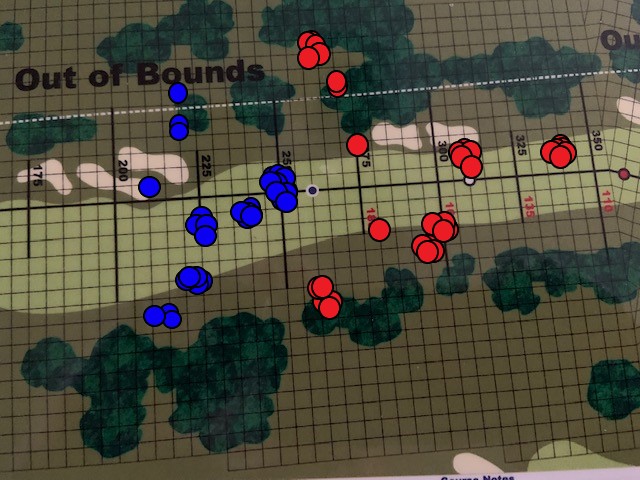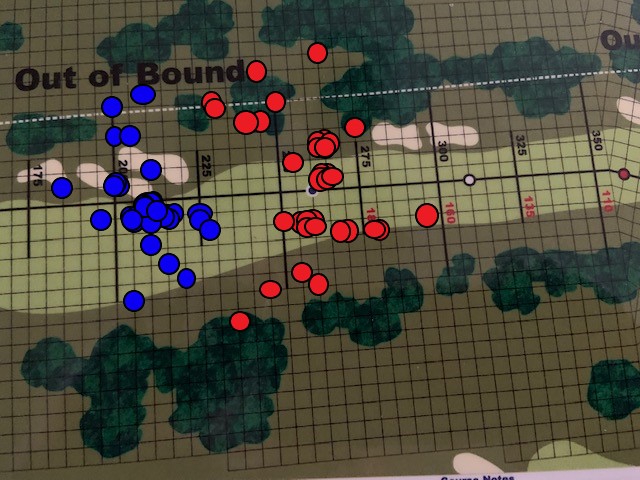I thought it might be interesting to look at the strategy of club selection when teeing off by using some extreme examples. For that reason, I decided to look at the differences between teeing off with a driver and a 2-Iron using two golfers with vastly different driving abilities.
The first golfer is Bryson DeChambeau (2021) who has an Average W rating of 1. Golfer #2 is Kevin Na (2021) who was randomly selected among five APBA golfers in 2021 with an Average W of 7.
I wanted the two players to have odd-numbered Average W ratings, because the hole I picked for this analysis (Peachtree #1) has an OB line that runs parallel to the centerline (CL) at a distance of about 30 yards. While an odd-numbered Average W rating is no guarantee that the overall tee-shot tendency will be to the left, at least by them both being odd numbers we’re comparing “apples to apples” (for whatever that’s worth).
Although it might have been strategic to aim in this situation, I did not. I simply plotted each Play Result Number–all 36 of them for both the driver and 2-Iron for each player. I didn’t factor in wind, but I did reduce the Carry of all tee-shots by 10 yards per the hole note. I also took the Average W “bonus” when it applied and changed all 2-Iron tee-shot results to the Average W on rolls of 14, 34, and 54 per the Master Game rule option. Ball rolls were applied (or not) based on terrain and in accordance with the rules.
Here is the dispersion of driver (red) and 2-Iron (blue) tee-shots for Bryson DeChambeau.

As you can see, under these conditions DeChambeau has a one-in-six chance of hitting the driver out-of-bounds, while with the 2-Iron it is one in 36. With the 2-Iron, he also has a much better chance of ending up in the fairway. In fact, only seven 2-Iron shots miss the fairway compared to 23 of the driver tee-shots.
It isn’t all bad with the driver, though. In addition to the extra yardage gained, about half the shots are either in the fairway or intermediate rough. However, on this 440-yard, par 4, it’s unlikely “Big Boy” DeChambeau would have trouble reaching the green in two, even with a maximum 2-Iron tee-shot of 250 yards.
Now, let’s take a look at Na. Here is the dispersion of driver (red) and 2-Iron (blue) tee-shots for him.

As expected, we see more distance and dispersion with the driver, although less so than with DeChambeau. Without aiming, Na may be better off with the driver since none of those shots end up in a fairway bunker compared to five that do with the 2-Iron. But his chance of hitting it OB with the driver is 5/36 versus 2/36 for the 2-Iron.
If Na were to aim 5 or 10 yards right with the 2-Iron, his odds of landing a tee-shot in the fairway improve even more. His second shot would probably need to go about 235 yards (including the extra 10 yards stipulated in the hole note), but that shouldn’t be a problem–assuming he is in the fairway and has at least a 4 Wood in his bag.
Obviously, wind is an important factor for club selection. This example doesn’t account for that. I also just compared drivers to 2-Irons. Other clubs might be more preferable in this situation.
Personally, I try to keep the ball in play as much as possible to avoid big numbers. As such, the 2-Iron (or other fairway wood) seems to me to be a better choice than the driver when errant tee-shots can be costly.